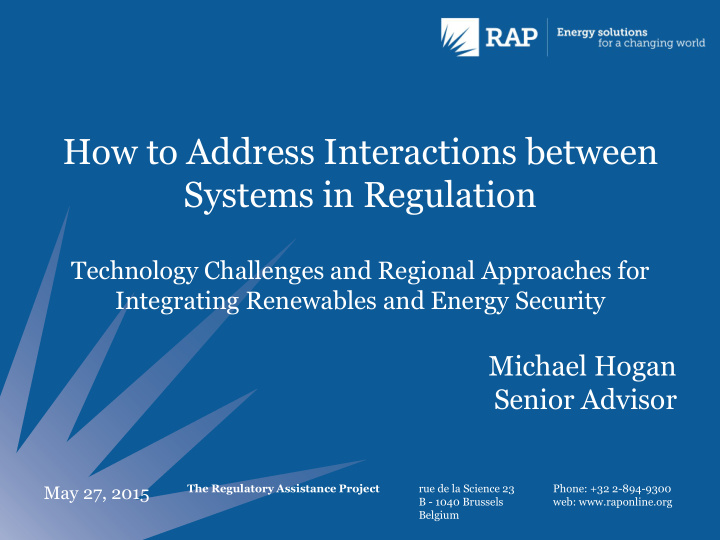



How to Address Interactions between Systems in Regulation Technology Challenges and Regional Approaches for Integrating Renewables and Energy Security Michael Hogan Senior Advisor May 27, 2015 The Regulatory Assistance Project rue de la Science 23 Phone: +32 2-894-9300 B - 1040 Brussels web: www.raponline.org Belgium
Supply & demand – the status quo… Supply Demand Source: Dr. Marco Nicolosi, Connect Economics 2
Supply & demand – the status quo… cap/VoLL peaker mid-merit baseload 3
…since 1929 4
Supply & demand – with proper energy market pricing… Supply Demand Remove price distortions, include DSR & co-optimize energy & balancing markets Source: Dr. Marco Nicolosi, Connect Economics 5
Supply & demand – new paradigm… Source: Dr. Marco Nicolosi, Connect Economics 6
Supply & demand – new paradigm… cap/VoLL action action action action peaker mid-merit baseload 7
…customers in charge 8
Current Proposal – “Add - on” to status quo 9
Coming soon – The dawn of the customer 10
1. Automated, price-responsive device controls express customer’s flexibility Refrigerator 4. Utility determines price at which grid Load (kW) Water Heater objective achieved, Price broadcasts it to Loa ($/kWh) Air Conditioner d consumers (kW) Load Price (kW) ($/kW h) Price ($/kWh) Price-Discovery Mechanism Customer Price-Flexibility Curve* Load Supply Limit Load (kW) (kW) Aggregate Demand Curve Max Load 3. Utility (all customers) Charge battery Load (kW) Charge battery * Labels removed aggregates Water heater before sending Water heater Q capacity to utility curves AC AC Base from all Discharge battery Load Price Discharge battery Price Price customers ($/kWh) ($/kWh) P clear ($/kWh) Transactive control concept 11
Hierarchical, nodal Transactive nodes Transactive Node: representation of localize price/incentive Aggregates flexible net demand power flow in grid to manage flow of power from nodes beneath it Generation Delivery + Consumption – Production – $ $ MW MW Expresses need for supply as feed- back to node(s) above it Transmission Transmission as function of price/incentive signal – $ $ $ $ MW MW MW MW Quantity & price at each node resolved via price-discovery Distribution Distribution process $ $ $ $ MW MW MW MW Implements price-responsive controls for its own flexible assets responsiveness is voluntary, set by – owner – response is automated on behalf of owner 12 Transactive control concept
The myth of fixed costs Source: Dr. Marco Nicolosi, Connect Economics 13
Breaking down barriers across sectors • Pry open markets to full competition – Adopt short-term auctions & products – Adapt qualifications for demand-side to participate – Regulate/eliminate incumbent supplier market power • Remove price distortions, eliminate price caps • Increase RES involvement in system balancing • Promote dynamic pricing options – Including dynamic allocation of non-energy charges • Phase out fixed & non-bypassable charges • Minimize the role of fixed capacity mechanisms • Promote increased responsiveness of CHP facilities 14
About RAP The Regulatory Assistance Project (RAP) is a global, non-profit team of experts that focuses on the long-term economic and environmental sustainability of the power and natural gas sectors. RAP has deep expertise in regulatory and market policies that: Promote economic efficiency Protect the environment Ensure system reliability Allocate system benefits fairly among all consumers Learn more about RAP at www.raponline.org Michael Hogan - Senior Advisor mhogan@raponline.org
Recommend
More recommend